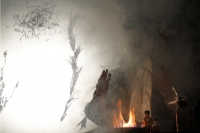BY: NAHUM MANTRA
- Published: Thursday, May 08 2014 13:42
There are always certain key events during one’s childhood that leave psychological and emotional marks forever. One would be wrong to ignore these experiences later in life.
I remember my first experience with magic. I must had been around 7 years old when David Copperfield performed in Mexico City. I cannot remember much of the show, except one trick where he makes a paper flower levitate, and then with a lighter, he burns it only to reveal a real rose. This image stayed with me for the years to come.
When I met Derren Brown in Shunt, who kindly gave me a DVD with one of his shows, that I just couldn’t live any longer without venturing into the underground world of performing magic and conjuring. After learning some effects, attending magic shows and magic conventions I started to research about what actually magic is.
I am interested in how magic works in our minds and the processes it triggers. Magic is a big word that conveys a series of meanings. Personally I am not interested in natural magic or so-called real magic. My fascination started with performance and with a very sceptical approach to anything magical. However, I am very interested in the workings of magical thinking.
It didn’t took me long to find some interesting connections between the space race and magical thinking. Some of these stories are well known within some circles in the space exploration world. Also I have to thank Nick Campionfor sharing his knowledge on this topic.
One of things that I learned about magical thinking and its impact in space activities goes back to an intriguing figure called Nikolai Federov. He is one of the precursors of Russian Cosmism. Federov believed that all human efforts should be focused on a common task that consisted of resurrecting every dead person in the human history. He though that we should design machines that can go to space and to colonise it. Then someone called Tsiolkovsky drew sketches and formulated math equations to make those machines possible. Eventually a lot of the science produced by Tsiolkovsky was employed for sending the Sputnik to space.
This is a perfect example of how magical thinking has had a massive impact in opening up the possibilities of space travelling. I could keep going on with many stories I have collected through the years but that’s not the point. I believe that magic is powerful and we should be more attentive to modern magicians. At the end of the day, they make the impossible happen.
In the summer of 2013 the French artist Anais Tondeurand myself worked together in a performance based on the Somnium by Johannes Kepler. In this performance we explored the different ideas of space travelling in Kepler’s time. We were intrigued in his particular way of solving a potential trip to the Moon. Kepler, who was familiar with magic because of his mother, wrote that by calling the devil of Levania he could send Duracotus to the Moon. During our performance we researched how this could have happened and eventually we performed the ritual. When we unveiled the demon, the audience realised that actually it looked more like a space rocket. I am sure that Kepler had recurred to magical thinking in order to envisage a real trip to the Moon to support the Copernican revolution.


One of the things that magic produces is enchantment. When we experience a magical or impossible thing unfolding in front of our eyes we experience the fantastical. I believe this feeling is connatural to the human being and we have a need to feel it. Max Weber said that, due to the secularization of the West because of its science and industrial development, the world was facing disenchantment. This involves losing the sense of awe and wonder experienced as science has been typically associated with coldness and extreme rationalism. It has also given society a certain sense of disconnection from the mysteries of the world.
It’s my personal belief that Weber was wrong and that space sciences are a powerful tool for enchanting our experience of the universe. During the fall of 2013 I was an artist in residence at Oboro, an extraordinary arts organisation in Montreal. Here I had a chance to develop a lecture performance where I explained through a series magic tricks how science could be seen as a story of magic.
Science and Re-enchantment from Nahum on Vimeo.
Also last year, in KOSMICA Mexico we had an entire session devoted to Magic in space. Here I invited Julijonas Urbonas to present a demonstration of the non-fiction of levitation. Also we had Nick Campion and Miguel Alcubierre, a superb Mexican scientist who has set the science behind travelling faster than light after watching an episode of Star Trek.
I will definitely keep developing more this strand of my research, as once again, space proves to be linked with even the most improbable thing: Magic.









Comments